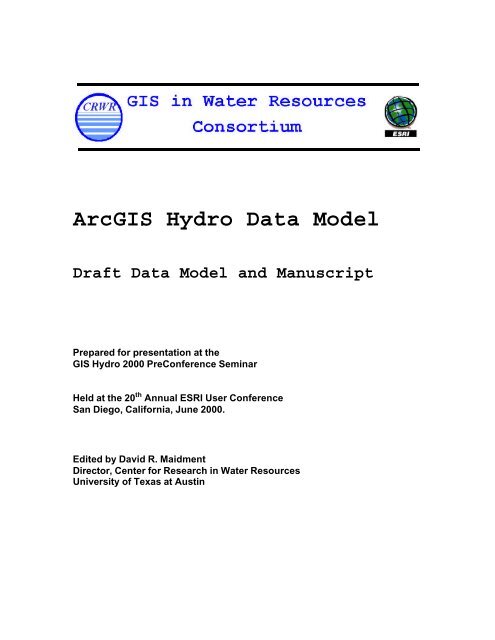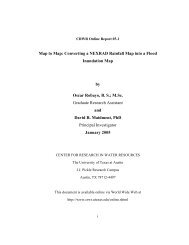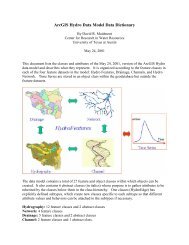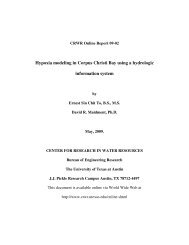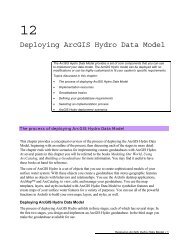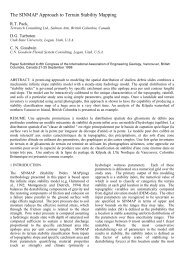ArcGIS Hydro Data Model - Center for Research in Water Resources ...
ArcGIS Hydro Data Model - Center for Research in Water Resources ...
ArcGIS Hydro Data Model - Center for Research in Water Resources ...
- No tags were found...
You also want an ePaper? Increase the reach of your titles
YUMPU automatically turns print PDFs into web optimized ePapers that Google loves.
<strong>Research</strong> Members<strong>Center</strong> <strong>for</strong> <strong>Research</strong> <strong>in</strong> <strong>Water</strong> <strong>Resources</strong>, University of Texas at Aust<strong>in</strong>Environmental Systems <strong>Research</strong> InstituteLower Colorado River Authority, TexasOffice of <strong>Water</strong>, US Environmental Protection AgencyTexas Natural <strong>Resources</strong> Conservation Commission<strong>Water</strong>shed Protection Department, City of Aust<strong>in</strong>, TexasTechnical MembersCamp Dresser and McKee IncDHI Institute <strong>for</strong> <strong>Water</strong> and Environment, DenmarkDodson and Associates, Houston, TexasWebsitehttp://www.crwr.utexas.edu/giswr
PrefaceThe <strong>ArcGIS</strong> <strong>Hydro</strong> <strong>Data</strong> <strong>Model</strong> is one of a series of Geo<strong>Data</strong>base models, which theEnvironmental Systems <strong>Research</strong> Institute (ESRI) is develop<strong>in</strong>g <strong>in</strong> collaboration withpartners. Each Geo<strong>Data</strong>base model is described <strong>in</strong> a book, at the back of which is a CD-ROM conta<strong>in</strong><strong>in</strong>g the model structure, and Geo<strong>Data</strong>bases <strong>for</strong> example applications of themodel. A Geo<strong>Data</strong>base model is a framework <strong>for</strong> captur<strong>in</strong>g key geographic anddescriptive <strong>in</strong><strong>for</strong>mation about a class of landscape features, and <strong>for</strong> attach<strong>in</strong>g behaviors tothe features. The Geo<strong>Data</strong>base is accessed us<strong>in</strong>g ESRI’s new ArcInfo version 8software, <strong>in</strong> which objects <strong>in</strong>teract through <strong>in</strong>terfaces designed accord<strong>in</strong>g a commonstandard.The <strong>ArcGIS</strong> <strong>Hydro</strong> <strong>Data</strong> <strong>Model</strong> was developed through a collaboration between ESRIand the <strong>Center</strong> <strong>for</strong> <strong>Research</strong> <strong>in</strong> <strong>Water</strong> <strong>Resources</strong> (CRWR) of the University of Texas atAust<strong>in</strong>. Together, ESRI and CRWR <strong>for</strong>med a Consortium <strong>for</strong> GIS <strong>in</strong> <strong>Water</strong> <strong>Resources</strong>to br<strong>in</strong>g together <strong>in</strong>dustry, government and academic partners <strong>in</strong> a jo<strong>in</strong>t ef<strong>for</strong>t to build adata model <strong>for</strong> surface water hydrology and hydrography. The collaborative ef<strong>for</strong>t wasmounted through a series of meet<strong>in</strong>gs, a GIS <strong>in</strong> <strong>Water</strong> <strong>Resources</strong> Conference, andsubstantial <strong>in</strong>teraction through the <strong>in</strong>ternet, to arrive at the data model structure described<strong>in</strong> this book. No s<strong>in</strong>gle <strong>in</strong>dividual could have conceived the whole model its structureis a synthesis of knowledge of the water resources area and of the capabilities of theArcInfo software, designed to operate efficiently with<strong>in</strong> those capabilities.This manuscript and the accompany<strong>in</strong>g CD-ROM were prepared <strong>for</strong> the GIS <strong>Hydro</strong> 2000PreConference Sem<strong>in</strong>ar held at the ESRI User Conference <strong>in</strong> San Diego <strong>in</strong> June 2000.Both the manuscript and the data model are draft versions <strong>in</strong>tended <strong>for</strong> review by the GIS<strong>in</strong> <strong>Water</strong> <strong>Resources</strong> community. Comments and suggestions as to how the manuscriptand model can be improved are welcome and solicited. After the model and manuscriptreview are completed, and appropriate adjustments made to their content, the <strong>ArcGIS</strong><strong>Data</strong> <strong>Model</strong> and accompany<strong>in</strong>g book will be published by ESRI Press.We wish to acknowledge the generous collaboration and support, which this ef<strong>for</strong>t hasreceived from the water resources community. In particular, the follow<strong>in</strong>g organizationshave f<strong>in</strong>ancially supported research ef<strong>for</strong>ts of the Consortium <strong>for</strong> GIS <strong>in</strong> <strong>Water</strong><strong>Resources</strong>: ESRI, US Environmental Protection Agency, Texas Natural <strong>Resources</strong>Conservation Commission, Lower Colorado River Authority, City of Aust<strong>in</strong>, Texas,Dodson and Associates, Camp, Dresser and McKee, and the DHI Institute <strong>for</strong> <strong>Water</strong>and Environment.Individuals from many other organizations also contributed <strong>in</strong><strong>for</strong>mation and suggestions.In particular we wish to acknowledge the contribution of the National <strong>Hydro</strong>graphy<strong>Data</strong>set program of the USGS and EPA whose development of a hydrographic datamodel <strong>for</strong> the United States was a significant guide to this ef<strong>for</strong>t. We thank all thosewhose ideas and support have contributed to the <strong>ArcGIS</strong> <strong>Data</strong> <strong>Model</strong>.
Chapters and AuthorsChapter 1 – IntroductionDavid Maidment, CRWR, and Scott Morehouse, ESRIChapter 2 – Conceptual FrameworkDavid Maidment, CRWRChapter 3 – <strong>Hydro</strong> NetworkKim Davis, CRWR, and Dale Honeycutt, ESRIChapter 4 – Catchments and <strong>Water</strong>shedsJordan Furnans and Francisco Olivera, CRWRChapter 5 – River ChannelsNawajish Noman and James Nelson, BYUChapter 6 – <strong>Hydro</strong> FeaturesKim Davis and Victoria Samuels, CRWRChapter 7 – Time SeriesMichael Blongewicz, DHIChapter 8 – Application to the Lower Colorado River Bas<strong>in</strong>Sarah Stone, CRWRChapter 9 – Application to the City of Aust<strong>in</strong>Tim Whiteaker and Kather<strong>in</strong>e Osborne, CRWRChapter 10 – Application to the Tr<strong>in</strong>ity-San Jac<strong>in</strong>to Coastal Bas<strong>in</strong>Victoria Samuels, CRWRChapter 11 – Creat<strong>in</strong>g a <strong>Data</strong> <strong>Model</strong> Extension <strong>for</strong> Flood Pla<strong>in</strong> Mapp<strong>in</strong>gKev<strong>in</strong> Donnelly, CRWRChapter 12 – Deploy<strong>in</strong>g the <strong>ArcGIS</strong> <strong>Hydro</strong> <strong>Data</strong> <strong>Model</strong>David Arctur and Bob Booth, ESRIAuthor’s Institutions:BYU: Environmental <strong>Model</strong><strong>in</strong>g <strong>Research</strong> Laboratory, Brigham Young University, UtahCRWR: <strong>Center</strong> <strong>for</strong> <strong>Research</strong> <strong>in</strong> <strong>Water</strong> <strong>Resources</strong>, University of Texas at Aust<strong>in</strong>DHI: DHI Institute <strong>for</strong> <strong>Water</strong> and Environment, DenmarkESRI: Environmental Systems <strong>Research</strong> Institute, Redlands, Cali<strong>for</strong>nia


